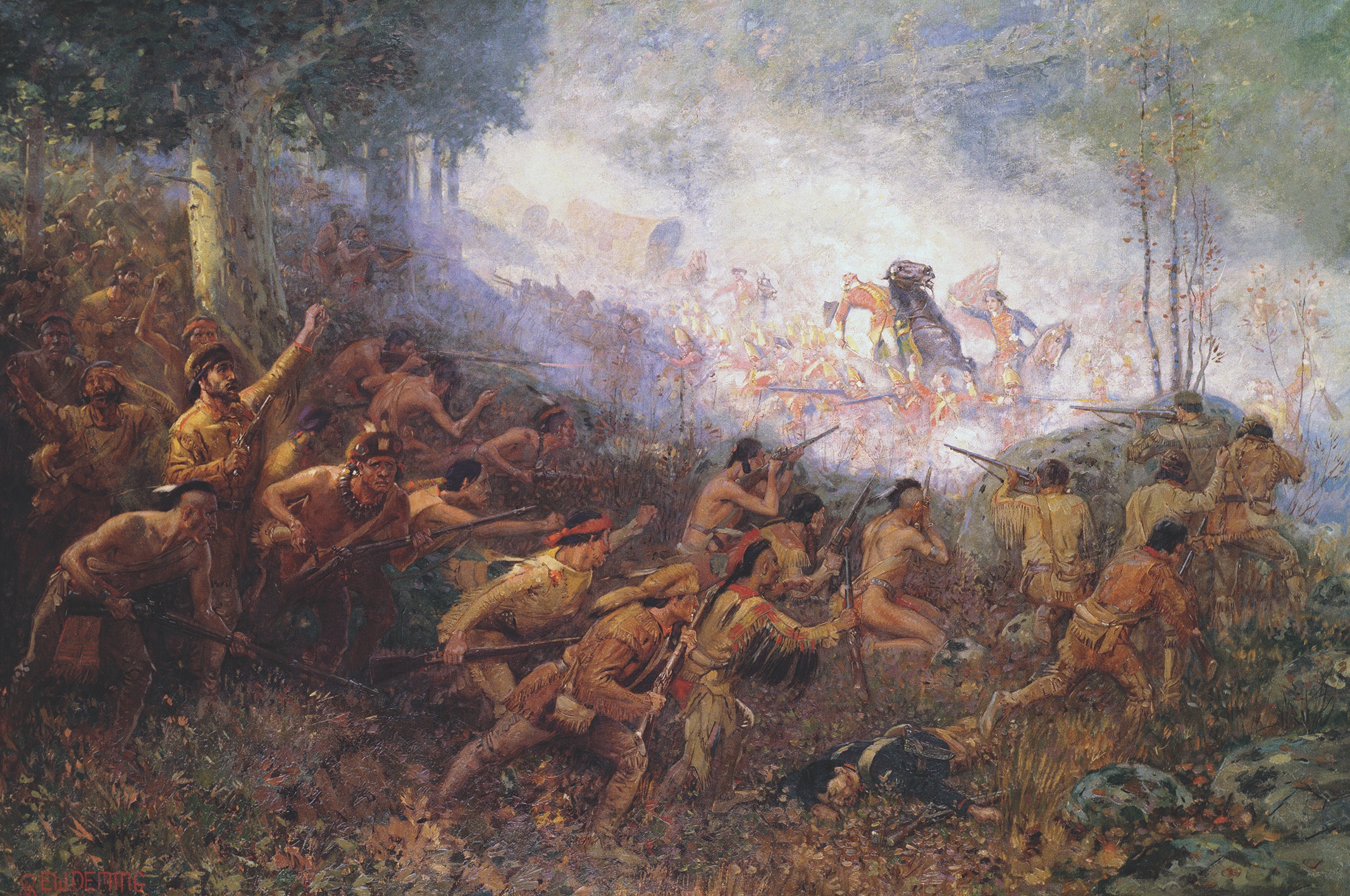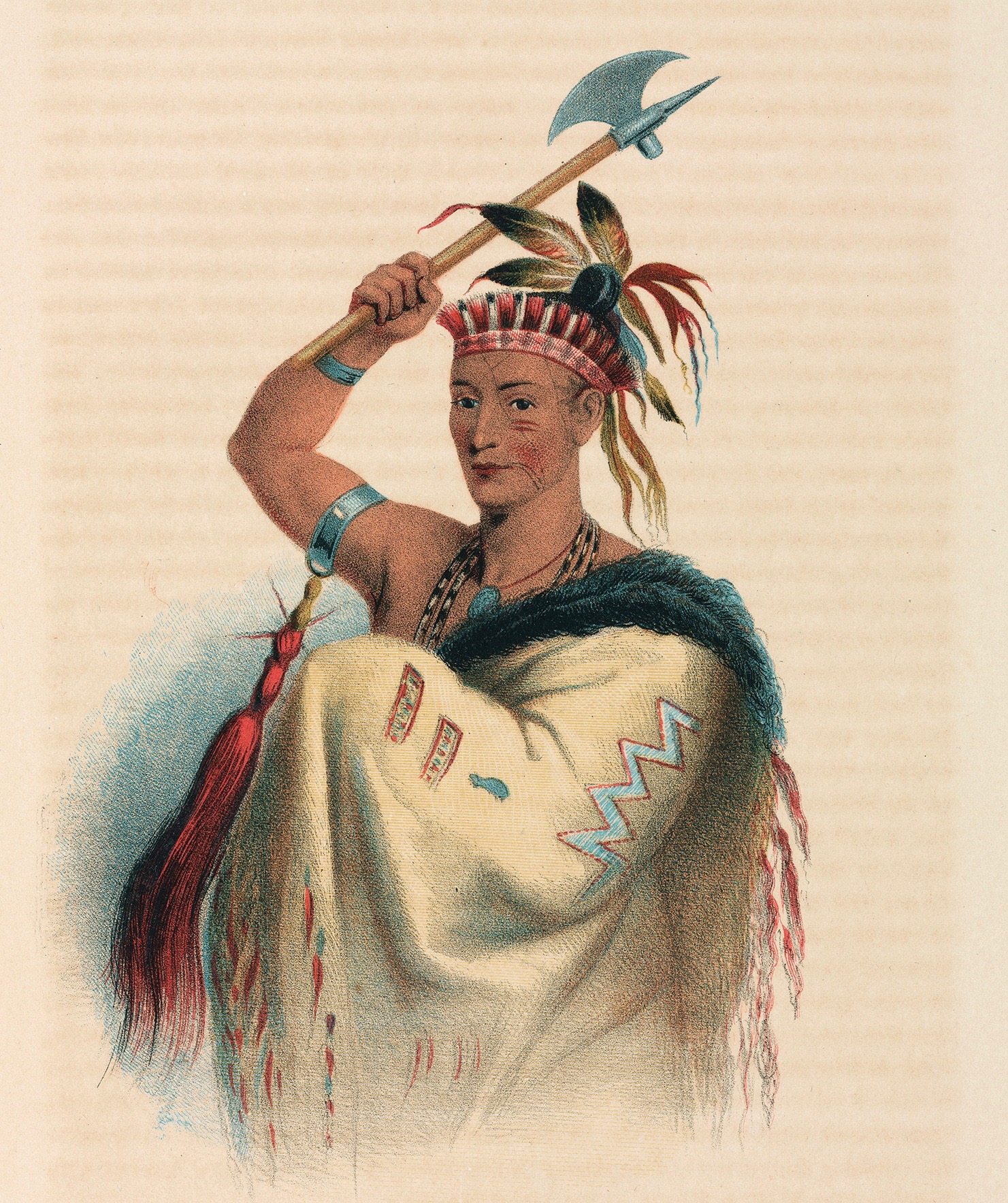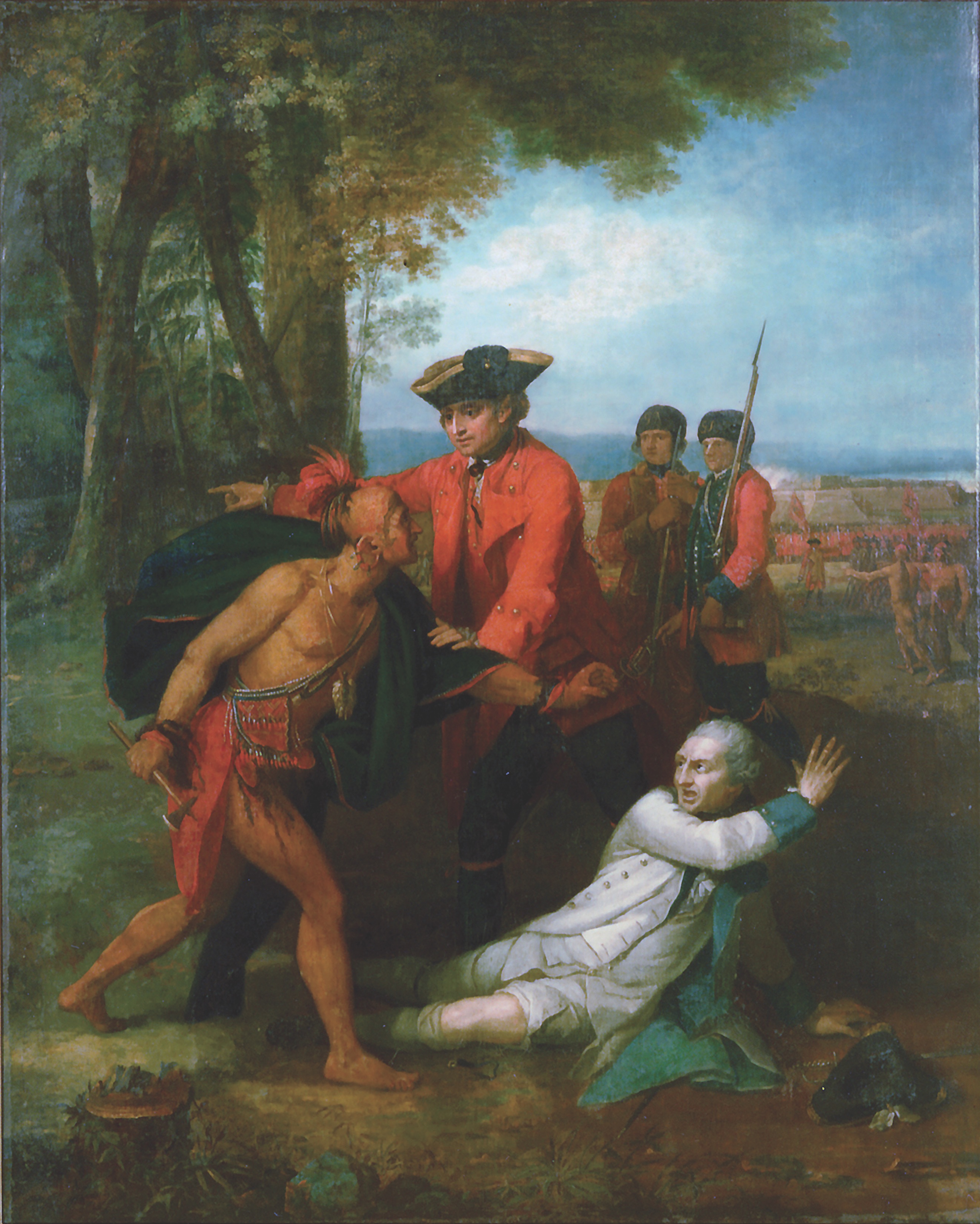The ignominious defeat of British Maj. Gen. Edward Braddock’s forces at the Battle of the Monongahela on July 9, 1755, had not only long-term repercussions on the course of the French and Indian War and the conduct of warfare in general, but also more immediate consequences. As conceived in an earlier meeting between Braddock and colonial governors in Alexandria, Va., the British would mount four campaigns against New France in 1755. Braddock’s main thrust had clearly failed, resulting in the deaths of nearly 500 men, including the general himself. Lt. Col. Robert Monckton’s early June siege of Fort Beauséjour, in Acadia (present-day New Brunswick), had succeeded. But a campaign against Fort Niagara, on Lake Ontario, led by Massachusetts Governor William Shirley, Braddock’s second-in-command, was delayed by logistical shortfalls, then cancelled altogether on news of Braddock’s death.
The last of the four campaigns, a colonial effort against Fort Saint-Frédéric, on Lake Champlain, was led by 40-year-old Sir William Johnson, New York’s appointed Iroquois agent, whom Braddock had commissioned as a major general. Thus a man with little military experience found himself at the head of an army of 3,500 colonial militiamen and upward of 250 Mohawk warriors. By mid-July, despite manpower issues and a persistent shortage of supplies, advance troops under Maj. Gen. Phineas Lyman had marched from Albany up the Hudson River to the point below a series of waterfalls where all navigation ceased, even for canoes and rafts. There, at a portage known as the Great Carrying Place, Capt. William Eyre of the Royal Engineers—the only British regular serving in the expedition—started work on a post he named Fort Lyman. Arriving soon after, Johnson diplomatically renamed the garrison Fort Edward, in honor of the prince, a grandson of King George II and younger brother of future King George III.
While Eyre kept busy on the stronghold, with 500 militiamen at his disposal, the bulk of the colonial army under Johnson cut a road 12 miles northwest through swampy woodlands to the head of Lac du Saint-Sacrement, which Johnson promptly renamed Lake George. By early September nearly 3,000 troops were encamped along the lake, and the siege artillery had arrived. All Johnson awaited from Albany was an additional supply of small boats and enough provisions to support his army in the field for a few weeks.

To the north the governor general of New France, Pierre de Rigaud, Marquis de Vaudreuil, was also keeping tabs on Fort Saint-Frédéric, as well as Johnson’s progress. The surprise victory over the British at the Monongahela and consequent capture of Braddock’s papers had presented the marquis a dilemma. Prior reports had indicated Shirley was having difficulty moving men and supplies to Fort Oswego, a British trading post on the southeast shore of Lake Ontario. Thus Vaudreuil had been marshalling his forces to launch a pre-emptive strike on the fort before Shirley’s army could reinforce it.
But after reading the reports of Johnson’s progress and studying the maps, Vaudreuil realized he would have to set aside any thoughts of Oswego and focus on the threat at hand. Twenty-year-old Fort Saint-Frédéric, which guarded the approach to Lake Champlain from South Bay, was known to be a crumbling mess. Its masonry walls were propped up with wooden supports in places, and although it boasted more than 60 cannons, its garrison was not strong enough to repel a concerted siege. Were Johnson to capture the fort, his army would be free to sail the length of Lake Champlain with impunity. Within a matter of days, Vaudreuil shuddered to think, 3,000 British troops could be on the outskirts of Montréal.
Suspending the Oswego operation, the governor general ordered its commander, Brig. Gen. Ludwig August von Dieskau—a German-born baron and protégé of the revered tactician Count Maurice de Saxe—to proceed to Fort Saint-Frédéric with the newly arrived Lan-guedoc and La Reine regiments, numbering some 260 grenadiers, joined by a mixed force of 800 Canadians and colonial marines and some 700 Indian allies. From there Dieskau would see to the security of the fort before dealing with Johnson’s army. If the British colonials, notorious for their poor conduct in battle, were anything like Braddock’s regulars, the general might quickly scatter Johnson’s forces and still return in time to launch an assault on Fort Oswego.
When Dieskau arrived at Fort Saint-Frédéric on August 17 he found it in ill repair, but the scouting parties he dispatched detected no immediate danger, so his men set to work. The fort seen to, Dieskau moved his force south 12 miles to the Ticonderoga peninsula. From there he could contest the passage into Lake Champlain from both the Lake George and South Bay invasion routes. Question was, which approach would Johnson use? In the interim, Dieskau dared not move forward, for fear of leaving open one of the routes to Fort Saint-Frédéric.
On September 2 an Abenaki scout returned to camp with a British prisoner. The captive informed the baron that Johnson had marched his army to the head of Lake George. He also told Dieskau that partially completed Fort Edward had yet to mount any cannons along its walls and was guarded by only 500 men. It was precisely the information Dieskau was seeking.
His plan was simple. With a force of 700 Canadians, 600 allied Indians and a detachment of French grenadiers—some 1,500 men in all—the general would continue down Lake Champlain by canoe to South Bay. There the troops would disembark and march south the 19 miles to Fort Edward. In taking the fort, Dieskau would cut Johnson’s supply line, forcing the latter to fall back in order to re-establish communications with Albany. Given there were only a half-dozen weeks left in the campaign season before the weather would make any siege impractical, the action would effectively end the British threat to Fort Saint-Frédéric.

By the evening of September 7 Dieskau’s force was encamped in the woods a few miles from Fort Edward. The general was arguing with his Indian allies over the plan of attack when two British prisoners were brought before him. The men stated Johnson was at Lake George with 3,000 colonials and their Mohawk allies. Furthermore, the British commander knew there was a French force in the area, but had no idea of its size or location. Convening with his Indian allies, Dieskau gave them the choice of following through with an attack on the fort or striking north to attack Johnson’s camp at Lake George. Loath to attack emplaced artillery, the chieftains opted to head north, further agreeing to return to besiege Fort Edward were the expedition successful.
Later that evening Johnson, having learned from a scout that a sizable French and Indian war party was en route to attack Fort Edward, sent a courier to warn the fort and convened a council of war. After some debate, Johnson proposed sending a 500-man detachment to the aid of the understrength garrison. King Hendrick, leader of Mohawks in camp, strongly objected. “If they are to fight, they are too few,” he said of the detachment. “If to be killed, they are too many.” His comment made an impression on the general, who resolved to double the number. At 8 a.m. on September 8 the 1,000-man relief force, under Massachusetts Col. Ephraim Williams, marched out of camp, followed soon after by Hendrick and his 250 Mohawks. A mile down the freshly cut road to Fort Edward, Hendrick and his fleet warriors took the lead. Fearing that deploying flankers would only slow the column, Williams traded speed for security and recklessly pressed forward, unaware of the danger that lay ahead.
Unfortunately for the Massachusetts commander, what lay ahead was a perfectly set ambush. On receiving reports from his own scouts of the British advance, Dieskau had selected a spot just south of the lake where the road threaded a narrow defile. There the baron deployed his Canadians and Indians in the forested slopes to either side, while his regulars blocked the road farther back. Williams’ column had entered Dieskau’s trap but not yet encountered the French regulars when a premature shot rang out from one of the Canadians or Indians. The misstep spared the British from annihilation, but they still paid dearly for their lack of caution, as seconds later the tree line east of the road lit up with jets of flame from a rolling volley of musket fire. The echoes of the opening barrage had not yet faded when followed by the rippling thunder of several hundred muskets from the tree line west of the road.
The British vanguard disintegrated. Hendrick, his pony shot from beneath him in the opening volley, was bayoneted where he fell, and Williams took a musket ball to the head while attempting to secure high ground, leaving the column leaderless. Moments later a deafening chorus of yells and war whoops rang out, as hundreds of Canadian troops and Indian warriors armed with knives, tomahawks and war clubs rushed in from either side of the road. The British column convulsed and then broke into headlong flight toward Lake George. Given the bloodthirsty tide following close on its heels, the shattered column would likely have been engulfed were it not for Lt. Col. Nathan Whiting’s disciplined rear guard, which delayed the enemy with a few well-timed volleys.
When the opening barrage reached Dieskau’s ears, he cursed the impatience of the Canadian irregulars and Indian warriors and ordered his grenadiers to advance. His opportunity slipping away, the baron quickly formulated another plan: First, he would push the British column back on its camp and exploit the confusion created by its return to cover an assault on the fortifications. Then, once atop the colonials, he would send his grenadiers on a bayonet charge, which he was convinced would turn the undisciplined provincials into a panicked mob.
The north end of Johnson’s camp abutted the lake, its flanks protected by swampy ground. The west and central portions of the position were buttressed by the three Massachusetts regiments. The remaining troops, the artillery and the bulk of the stores lay along the east side, where the road entered the encampment. No defensive works had been erected, and although the colonial troops had cleared most of the ground within the encampment, the perimeter, with the exception of an open area along the road, remained a tangled mass of brush and broadleaf trees. At the sound of approaching gunfire, the British troops scrambled to raise a makeshift breastwork, piling up felled trees, wagons and even overturned boats about the perimeter of the camp. The men also hauled three heavy cannons into position opposite the road and manhandled a fourth gun atop a hill along the camp’s eastern edge. By the time Williams’ panicked troops started pouring into camp, the barricade was no more than a few feet high in many places.
While the return of the British detachment had created the confusion Dieskau had anticipated, he remained more than a half-mile away, still dickering with his field commanders. The Canadians and Indians were exhausted from the running battle, and neither group was interested in attacking a fortified camp supported by cannons. Dieskau, whose family crest reportedly bore the legend Boldness Wins, was determined to press his advantage. His grenadiers would attend to the British guns, he promised the Canadians and Indians. All they had to do was rush the barricade, which, he pointed out, was “of trifling height.”
Forming his regulars into a column, Dieskau sent them marching down the road against the British position, and although it took some persuading, the Canadian and Indian contingents began filtering through the woods toward Johnson’s camp. While most obeyed the general’s orders, it was clear many did not, and it was also clear those who did had no intention of brazenly storming the British lines.
Meanwhile, the brief pause in the fighting had given Johnson and his officers precious time to calm their frightened troops and stabilize their hastily arranged lines. Sporadic firing broke out as concealed Canadians and Indians probed the breastwork from the trees. Then came a rattle of drums, as the French regulars marched into view on the road. Johnson’s officers deployed their men as Dieskau’s white-coated formation advanced to within 100 yards. While terror froze many of the provincial troops, Capt. Eyre, in command of the cannons deployed across from the French formation, finally gave the order to fire. While the sound of the guns bolstered the British troops’ spirits, the muzzles were set too high, and the balls sailed harmlessly into the trees beyond. French troops then opened a crashing fire by platoon on the British lines. Perhaps due to frayed nerves, their volleys, too, were poorly aimed and did little damage. Johnson’s men then returned fire.
An alarmed Dieskau had noticed the paralyzing effect the sound of Eyre’s guns had had on the irregulars, particularly his Indian allies. Another such barrage might send them running. Standing near the front of the white-coated formation, the French general drew his sword and cried out, “March! Let us force the place!” The baron had barely taken a step, however, when a musket ball struck him in the leg. His second-in-command, Lt. Col. Pierre-André Gohin, Comte de Montreuil, who had also been wounded, urged the general to retire, but Dieskau would have none of it. Montreuil was cleansing out the general’s wound with brandy when two more balls hit the baron, in the right knee and left hip. A third ball smacked into Montreuil’s cartridge box.
For the aggressors the situation was becoming perilous. While the fire from the Rhode Island and Connecticut regiments in front of them was galling enough, Eyre’s gunners had finally found the range and, according to one witness “made lanes, streets and alleys” through the French formation. With his losses mounting and finding it impossible to advance in order, Dieskau ordered his men to disperse into the woods on either side of the road.
By that point the Canadians and Indians on the French left had reached the tree line in front of Johnson’s encampment and opened fire from concealment on the British lines. A deadly game of hide-and-shoot took hold over the next few hours, the opposing marksmen exposing themselves only an instant in order to fire, then ducking behind whatever cover was available to reload their muskets. One Massachusetts soldier described the fight as “nothing but thunder and lightning and perpetual pillars of smoke,” while another claimed the gunfire roared uninterrupted for hours, the bullets humming past his ears like hailstones.
By 4 p.m. the rate of French fire had diminished, as most of the Canadians and Indians had seen enough and returned to where they’d left their packs at the site of Williams’ ambush. Unable to move, the thrice-wounded Dieskau had ordered Montreuil to take command. On being shot once more by a wary enemy scout, the baron was carried into the British camp a prisoner.
There was nothing left for Montreuil to do but order his drummers to beat the retreat. While Johnson’s badly shaken force was in no condition to interfere with the French withdrawal, Montreuil’s men did run into a 120-man detachment of British soldiers sent out from Fort Edward under Capt. Nathaniel Folsom, a future American general. The forces skirmished near the site of Williams’ ambush for a few hours before the more numerous French broke off the engagement and set out for South Bay. By September 10 Montreuil’s men were back at Ticonderoga.
While the French had suffered somewhat fewer casualties, the British claimed victory, because they held the field at the end of the day. Dieskau, who would recover from his wounds and return home at war’s end in 1763, had plenty of time to brood over how so much could go from right to wrong in a single campaign. He had improvised on the fly and inflicted a major defeat on the British. Not satisfied with this, however, he had attacked an entrenched army, one that not only outnumbered him but also was largely rested and ready. It was a gamble against long odds, but true to his family crest Dieskau had cast the die—and lost.
For his part, Johnson had divided his army in front of an unknown enemy, walked into an ambush and managed to avoid annihilation only out of dumb luck, yet he was hailed as “a second Marlborough for coolness of head and warmness of heart.” In appreciation, King George II made him a baronet, and Parliament presented him with £5,000 as a token of thanks. His badly shaken men, who spent the days after battle burying close to 200 compatriots, did not necessarily share this view of victory.
Although defeated, Dieskau had accomplished his task. The battle had broken the colonial army’s spirit, and Johnson knew it. As the autumn rains set in, it became clear there would be no attack on Fort Saint-Frédéric. Instead, the British at Lake George spent the remaining months before winter erecting Fort William Henry, while the French at Ticonderoga built Fort Carillon. The respective armies retired to winter quarters in late November, but it was certain they would be back at each other’s throats come spring.
Michael C. Laramie is the author of three books on the military history of colonial North America. For further reading he recommends his own The European Invasion of North America, as well as The Battle of Lake George, by William R. Griffith IV, and The Life and Times of Sir William Johnson, Bart, by William L. Stone.





